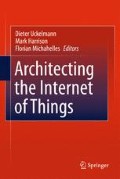Abstract
Many of the initial developments towards the Internet of Things have focused on the combination of Auto-ID and networked infrastructures in businessto- business logistics and product life cycle applications. However, a future Internet of Things can provide a broader vision and also enable everyone to access and contribute rich information about things and locations. The success of social networks to share experience and personalised insights shows also great potential for integration with business-centric applications. The integration and interoperability with mainstream business software platforms can be enhanced and extended by real-time analytics, business intelligence and agent-based autonomous services. Information sharing may be rewarded through incentives, thus transforming the Internet of Things from a cost-focused experiment to a revenue-generating infrastructure to enable trading of enriched information and accelerate business innovation. Mash-ups and end-user programming will enable people to contribute to the Internet of Things with data, presentation and functionality. Things-generated physical world content and events from Auto-ID, sensors, actuators or meshed networks will be aggregated and combined with information from virtual worlds, such as business databases and Web 2.0 applications, and processed based on new business intelligence concepts. Direct action on the physical world will be supported through machine-interfaces and introduction of agile strategies. This chapter aims to provide a concept for a future architecture of the Internet of Things, including a definition, a review of developments, a list of key requirements and a technical design for possible implementation of the future Internet of Things. As open issues, the evaluation of usability by stakeholders in user-centric as well as business-centric scenarios is discussed and the need for quantifying costs and benefits for businesses, consumers, society and the environment is emphasised. Finally, guidelines are derived, for use by researchers as well as practitioners.
Access this chapter
Tax calculation will be finalised at checkout
Purchases are for personal use only
Preview
Unable to display preview. Download preview PDF.
References
Aberer K, Hauswirth M, Salehi A (2006) Global Sensor Networks, Technical report LSIRREPORT- 2006-001. http://lsirpeople.epfl.ch/salehi/papers/LSIR-REPORT-2006-001.pdf. Accessed 1 May 2010
Basagni S (1999) Distributed Clustering for Ad Hoc Networks. Proc. ISPAN’99 Botts M, Percivall G, Reed C, Davidson J (2006) OGC Sensor Web Enablement: Overview and High Level Architecture. Open Geospatial Consortium Whitepaper.
http://portal.opengeospatial.org/files/?artifact_id=25562. Accessed 1 May 2010
Bullinger H-J, ten Hompel M (2007) Internet der Dinge. Springer, Berlin
BRIDGE (2009) Sensor-based Condition Monitoring. http://www.bridge-project.eu/data/File/BRIDGE_WP03_sensor_based_condition_monitoring.pdf. Accessed 5 July 2010
Brock L (2001) The Electronic Product Code (EPC) – A naming Scheme for Physical Objects. http://autoid.mit.edu/whitepapers/MIT-AUTOID-WH-002.PDF. Accessed 5 July 2010
CERP-IoT (2009) Internet of Things Strategic Research Roadmap, http://www.grifsproject.eu/data/File/CERP-IoT%20SRA_IoT_v11.pdf. Accessed 1 May 2010
Clendenin M, (2006) China aims for homegrown RFID spec by '07. http://www.embedded.com/news/embeddedindustry/191600488?_requestid=355245. Accessed 1 May 2010
Dimokas N, Katsaros D, Manolopoulos, Y (2007) Node Clustering in Wireless Sensor Networks by Considering Structural Characteristics of the Network Graph. Proc. ITNG’07,IEEE Computer Society, USA.
EPCglobal (2007) The EPCglobal Architecture Framework, Standard Specification. www.epcglobalinc.org/standards/architecture/architecture_1_2-framework-20070910.pdf. Accessed 1 Mai 2010
EPCglobal (2010) EPCglobal Certification Program. http://www.epcglobalinc.org/certification/. Accessed 7 July 2010
EPC Symposium (2003) Inaugural EPC Executive Symposium. http://xml.coverpages.org/EPCSymposium200309.html. Accessed 5 July 2010
EPoSS (2008) Internet of Things in 2020 – A roadmap for the future. http://old.smart-systemsintegration.org/internet-of-things/Internet-of-Things_in_2020_ECEPoSS_Workshop_Report_2008_v3.pdf. Accessed 1 May 2010
Fleisch E, Mattern F (2005) Das Internet der Dinge: Ubiquitous Computing und RFID in der Praxis: Visionen, Technologien, Anwendungen, Handlungsanleitungen. Springer, Berlin
Floerkemeier C, Fleisch E, Langheinrich M, Mattern, F (2008). The Internet of Things: First International Conference, IOT 2008. Springer, Berlin
Gille D, Strücker J (2008) Into the Unknown – Measuring the Business Performance of RFID Applications. 16th European Conference on Information Systems (ECIS 2008). http://is2.lse.ac.uk/asp/aspecis/20080218.pdf. Accessed 1 May 2010
Hackathorn R (2004) The BI Watch: Real-Time to Real-Value. http://www.bolder.com/pubs/DMR200401-Real-Time%20to%20Real-Value.pdf. Accessed 1 May 2010
Heise online (2008) Frankreich schlägt europäische Root für das "Internet der Dinge" vor. http://www.heise.de/newsticker/meldung/Frankreich-schlaegt-europaeische-Root-fuer-das-Internet-der-Dinge-vor-209807.html. Accessed 1 Mai 2010
Laubacher R, Kothari S, Malone TW, Subirana B (2006). What is RFID worth to your company? Measuring performance at the activity level. ebusiness.mit.edu/research/papers/223%20 Laubacher_%20APBM.pdf. Accessed 1 Mai 2010
Muguet F (2009) A written statements on the subject of theHearing on future Internet
Governance arrangements – Competitive Governance Arrangements for Namespace Services. http://ec.europa.eu/information_society/policy/internet_gov/docs/muguet_eu_internet_hearing.pdf. Accessed 27 October 2010
Sánchez López T (2010) What the Internet of Things is NOT. http://technicaltoplus.blogspot.com/2010/03/what-internet-of-things-is-not.html. Accessed 1 May 2010
Sánchez López T, Kim D, Canepa GH, Koumadi K (2009) Integrating Wireless Sensors and RFID Tags into Energy-Efficient and Dynamic Context Networks. Comput J 52:240-267. doi:10.1093/comjnl/bxn036
Santucci Gérald (2010) The Internet of Things: Between the Revolution of the Internet and the Metamorphosis of Objects. http://ec.europa.eu/information_society/policy/rfid/documents/iotrevolution.pdf. Accessed 18 October 2010
Shim Y, Kwon T, Choi Y (2007) SARIF: A novel framework for integrating wireless sensors and RFID networks, IEEE Wirel Commun14: 50-56. doi:10.1109/MWC.2007.4407227
Sung J, Sánchez López T, Kim D (2007) The EPC Sensor Network for RFID and WSN Integration Infrastructure. Pervasive Computing and Communications Workshops, Fifth IEEE International Conference on Pervasive Computing and Communications Workshops (PerComW'07)
Uckelmann D, Isenberg MA, Teucke M, Halfar H, Scholz-Reiter B (2010) An integrative approach on Autonomous Control and the Internet of Things. In: Ranasinghe DC, Sheng QZ, Zeadally S (eds) Unique Radio Innovation for the 21st Century: Building Scalable and Global
RFID Networks. Springer, Berlin
Wang Y, Zhao Q, Zheng D (2004) Energy-Driven Adaptive Clustering Data Collection Protocol in Wireless Sensor Networks. Proc. ICMA’04. http://ieeexplore.ieee.org/stamp/stamp.jsp?arnumber=01384266. Accessed 1 May 2010
Ye M, Li C, Chen G, Wu J (2005) An Energy Efficient Clustering Scheme in Wireless Sensor Networks. Proc. IPCCC’05, Phoenix, USA
Younis O, Fahmy S (2004) HEED: A Hybrid, Energy-Efficient, Distributed Clustering Approach for Ad Hoc Sensor Networks. IEEE Trans Mob Comput 3:366-378. doi:10.1109/TMC.2004.41
Author information
Authors and Affiliations
Editor information
Editors and Affiliations
Rights and permissions
Copyright information
© 2011 Springer-Verlag Berlin Heidelberg
About this chapter
Cite this chapter
Uckelmann, D., Harrison, M., Michahelles, F. (2011). An Architectural Approach Towards the Future Internet of Things. In: Uckelmann, D., Harrison, M., Michahelles, F. (eds) Architecting the Internet of Things. Springer, Berlin, Heidelberg. https://doi.org/10.1007/978-3-642-19157-2_1
Download citation
DOI: https://doi.org/10.1007/978-3-642-19157-2_1
Published:
Publisher Name: Springer, Berlin, Heidelberg
Print ISBN: 978-3-642-19156-5
Online ISBN: 978-3-642-19157-2
eBook Packages: EngineeringEngineering (R0)

